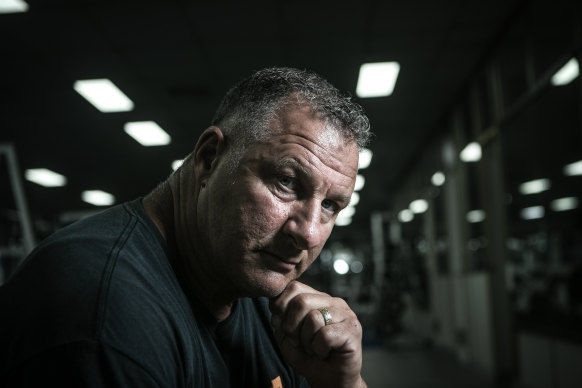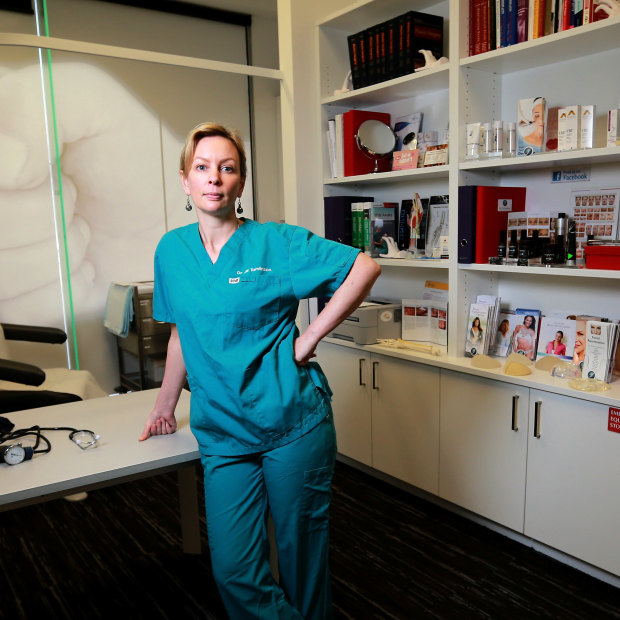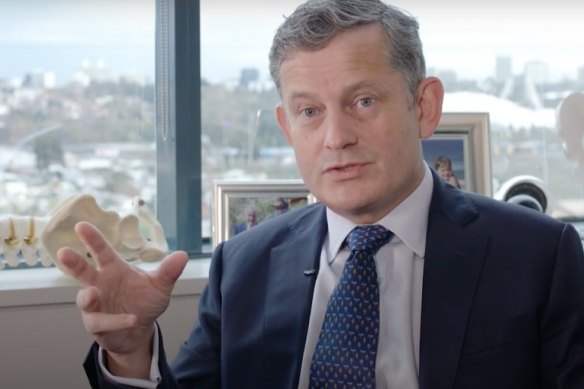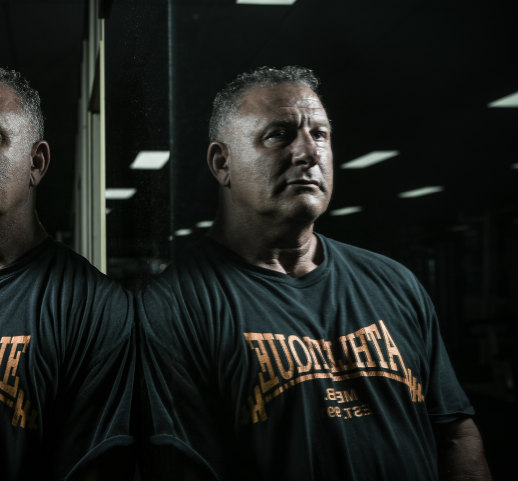‘You just break down’: The long, agonising wait for surgery in Victoria
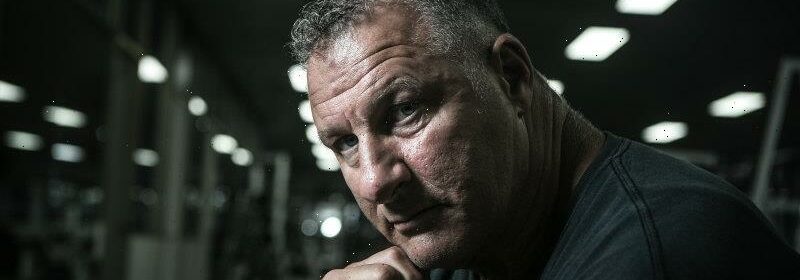
By Melissa Cunningham
Phil Muscat constantly feels like his hand has been slammed in a door.
It is a kind of excruciating pain that shoots up through his fingertips, radiates down the right side of his body, and leaves him unable to walk up flights of stairs without clutching onto handrails.
Phil Muscat has been waiting for a discectomy, a procedure to remove a degenerative disc in his neck, for two years.Credit:Justin McManus
“I’m a bit of a tough nut who can handle a lot of pain, but sometimes you just break down,” Muscat said. “You can’t sleep. It’s just pain all day, every day.”
For two years, the 57-year-old has been living in daily agony, while he waits for a discectomy, a procedure to remove a degenerative disc in his neck. He is one of thousands of Victorians who have been left languishing for years on the state’s record-long elective surgery waitlist.
In a significant pre-election health pitch, the Victorian government promised elective surgery would be cranked up to 125 per cent of pre-pandemic levels, with an extra 40,000 operations to be undertaken this year, building up to 240,000 every year from 2024.
But serious doubts are being cast over the ability of the $1.5 billion plan to clear the massive backlog.
Australian Medical Association Victorian vice president Dr Jill Tomlinson said she is yet to see any evidence the state will be able to perform the additional 40,000 surgeries it promised this year.
“It is going to take years to get on top of this,” she said. “While the investment is extremely welcome, our biggest, biggest issue continues to be workforce. I am not convinced that the new facilities announced will be sufficient.”
Dr Jill Tomlinson, Australian Medical Association Victorian vice president, can’t see how 40,000 extra elective surgeries can be completed in the state this year.Credit:Wayne Taylor
Leading Victorian orthopaedic surgeon John Cunningham said public patients on his list for spinal surgery were facing delays of more than two years and wait times continued to climb.
“My public elective surgery waiting list is catastrophic,” Cunningham said. “That’s a fair and realistic adjective to use for it.”
Tomlinson said severe shortages of nurses, doctors, surgeons, physiotherapists and even clerical staff were plaguing hospitals, leading to ongoing delays of essential surgery, such as joint replacements and hernia repairs.
Victoria has almost 135,000 patients on the elective surgery waitlist, close to 60,000 more people than the estimated backlog of 77,845 in New South Wales, according to a new analysis by the Australian Medical Association.
The analysis indicated Victoria makes up 44 per cent of the country’s entire elective surgery backlog, the legacy of 150 days of restrictions on surgery during lockdowns and the battering of hospitals amid continual coronavirus waves.
Victoria’s official surgical waitlist stands at 84,955. The AMA said their analysis included the backlog of people who have not yet been added to the official waitlist as well as those with debilitating and painful chronic conditions who have been waiting more than three years to see a specialist.
Cunningham, who treats both public and private spinal surgery patients, said all major metropolitan hospitals in Melbourne were balancing soaring public surgical waitlists, alongside increasing numbers of trauma patients, who require urgent surgery.
Orthopaedic surgeon John Cunningham says his public elective surgery waiting list is ‘catastrophic’.
“I only get through one elective spinal surgery case a month at the moment and I’m putting two or three patients on the list every fortnight,” Cunningham said.
“I only get through one elective spinal surgery case a month at the moment and I’m putting two or three patients on the list every fortnight.”
Patrick Lo, chair of the Royal Australasian College of Surgeons in Victoria, said the government investment had failed to filter through yet, and he was doubtful the state could realistically churn through an extra 40,000 surgeries this year.
“It’s not going to be a steep drop, it will be more of a slow burn,” Lo said.
However, the neurosurgeon warned investments into combating elective surgery waiting lists failed to address Australia’s struggling primary healthcare system, including GP shortages.
Lo said an inability to afford a doctor’s appointment and delays in booking in with overrun GPs had meant extraordinary numbers of Victorians, who had delayed medical care during the pandemic, were now landing in emergency departments seriously ill and requiring urgent surgery or hospital beds.
Lo said pre-pandemic surgical patients could spend more than a week in hospital following surgery, but health services were now completely overwhelmed and there were not enough beds. “These old ways cannot be recovered,” Lo said. “Those days must be gone.”
As part of the $1.5 billion plan, Victorian hospitals will be operating at night and on weekends to try to catch up. Frankston Private Hospital is set to be effectively taken over by the state government, and run as a public surgery centre, in the hope it will handle up to 9000 public patients a year, from this year. The Bellbird Private Hospital in Blackburn will also be transformed into a public surgery centre.
You would not know it by looking at Muscat, a burly personal trainer, who has spent years weightlifting, but the right side of his body is slowly wasting away.
“One arm is bigger than the other, one pec muscle is bigger than the other,” he said. “I’ve got a wasted calf, wasted quad and hamstring on my right side. All that muscle that takes years of building up just goes in weeks. It has actually robbed me of my personality a little bit.”
Phil’s chronic pain impacts every aspect of his life.Credit:Justin McManus
An MRI recently detected that Muscat also now has spinal stenosis, caused by the narrowing of the cervical spinal canal. The severe pain in his back is being intensified by one of his discs pushing onto his spinal cord, which he requires spinal surgery for.
“I went back to my GP and basically just broke down in his office,” Muscat said.
“I told him ‘I can’t do this anymore’ and he went into bat for me. He’s ringing up the hospital saying ‘this needs to be done now’.”
Muscat said having his surgery booked in and then cancelled during the pandemic was akin to psychological torture. He is still waiting for an official date to be confirmed for both his surgeries.
“You build up all your hopes, and you think I’m finally going to get fixed and then somebody says ‘you’re not getting your surgery mate’ and the depression sort of starts to come into it,” Muscat said.
Both Muscat’s neck and back procedures have been deemed category-two surgery, which means under existing guidelines, the procedures should be undertaken within 90 days, due to significant pain and disability.
Years of being employed in manual labor in his younger years as bricklayer, landscaper and then concreter, have taken a punishing toll on Muscat’s body.
“I went back to my GP and basically just broke down in his office.”
On top of healthcare workforce constraints there remains a dire shortage of surgical theatres for an ageing and growing population, Cunningham said.
While government investments, including a new campus for the Royal Melbourne Hospital at the Arden precinct, will create space for 10,500 additional elective surgeries annually, he said, these projects were years off completion.
Cunningham is concerned by the increasing number of people dipping into their savings or raiding their superannuation to pay for their surgery. He urged Victorians to seriously consider private health insurance if they could afford it.
“My heart just goes out to these people who have no choice but to rely on the public system,” Cunningham said.
“It is absolutely miserable, particularly among younger people of working age, who have a young family and are often self-employed. They are really, really suffering.”
A Victorian government spokesman said more than 4500 healthcare workers have been hired and trained in the past year.
Recent state government estimates suggest there has been a 64 per cent rise since the COVID-19 catch-up plan was announced last year.
The Morning Edition newsletter is our guide to the day’s most important and interesting stories, analysis and insights. Sign up here.
Most Viewed in National
Source: Read Full Article
